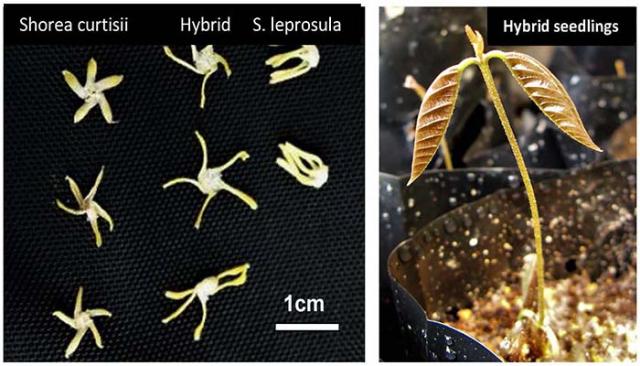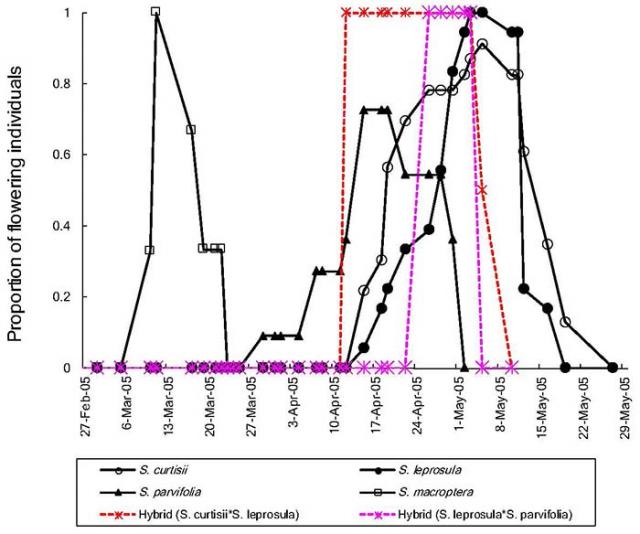Home > Research > Research Results > Research Results 2019 > Hybridization of trees is promoted in fragmented tropical rain forests
Update:March 8, 2019
Main content starts here.
Hybridization of trees is promoted in fragmented tropical rain forests
| Article title |
Overlapping flowering periods among Shorea species and high growth performance of hybrid seedlings promote hybridization and introgression in a tropical rainforest of Singapore |
|---|---|
| Author (affiliation) |
Tanaka Kenzo (a), Koichi Kamiya (b), Kang Min Ngo (c), Nik Faizu (d), Shawn Kaihekulani Yamauchi Lum (c), Shuichi Igarashi (b), Yuki Norichika (e), Tomoaki Ichie (e) (a) Department of Plant Ecology, FFPRI, Tsukuba, Ibaraki, Japan. (b) Ehime University, Matsuyama, Ehime, Japan. (c) Nanyang Technological University, Singapore, Singapore. (d) Center for Tropical Forest Science, Singapore, Singapore. (e) Kochi University, Nankoku, Kochi, Japan. |
| Publication Journal |
Forest Ecology and Management, 435:38-44, Elsevier, March 2019 DOI:10.1016/j.foreco.2018.12.038( External link ) |
| Content introduction |
The tropical rain forests of Southeast Asia possess high biodiversity, and approximately 500 species of dipterocarp trees exist and dominate in the forests. Interspecific mating is very rare in intact tropical rain forests; this has helped preserve the genetic uniqueness of each species and the biodiversity of the forests. However, dipterocarp trees hybridize with high frequency in fragmented rain forests owing to human activities. To maintain species uniqueness, genetic contamination (genetic pollution) between species through hybridization must be understood by investigating flowering phenology and fertility of seedlings of the hybrid. In the present study, the flowering periods of mature trees in first-generation hybrid (F1) and closely related species were observed. It was found that the flowering period of the F1 trees and those of closely related species overlap and that the seeds resulting from hybridization have the ability to germinate. Additionally, genetic analysis of seedlings originating from F1 trees revealed that genetic interactions existed between closely related species with various combinations, including a backcross with the parental species and mating between the F1 species. Furthermore, the growth and survival rates of these seedlings were higher than those of the parental and closely related species, making these seedlings more competitive in terms of survival. Therefore, hybridization of dipterocarp trees may accelerate in fragmented rain forests. Moreover, there is a greater risk for these species to lose their genetic identity through genetic contamination among closely related species. These findings could help develop proper techniques to maintain tropical rain forests without the risk of hybridization, such as determining the protection area necessary for sustainable preservation of the forests with high biodiversity. Note: Genetic contamination is defined as the loss of genetic purity in the original species owing to mixing of genes through backcrosses and hybridization between closely related species instigated by human intervention. This is also known as genetic pollution or introgression.
Photo 1: Hybridization of dipterocarp trees among the Shorea genus; flowers of the hybrid and parental species (left), and hybrid seedlings (right) Trees in tropical rain forests of Southeast Asia, including dipterocarp trees, blossom and bear fruit every 3–10 years. Flowers of the hybrid Shorea genus have an intermediate shape between S. curtisii and S. leprosula, which are closely related species (left). Reproductive organs functioned normally, and healthy seedlings were found to germinate from the seeds (right).
The flowering periods of two types of hybridized dipterocarp trees from the Shorea genus overlapped with those of the parental and closely related species. The same insects transport the pollen from these species, which may cause backcrosses between the parental species and mating between hybridized species, thereby increasing the possibility of genetic interaction between multiple species through hybridized species. |
Copyright © Forest Research and Management Organization. All rights reserved.


